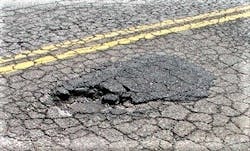Consumers with flat tires may be surprised to find they were stopped in their tracks by a spoon. Or wrench. Or pair of pliers. But finding kitchen utensils and tools in flat tires is not a surprise to automotive service technicians.
According to a new national survey conducted by Auto Service Professional, a sister publication of Modern Tire Dealer, there are a lot of potential hazards likely to damage tires if drivers are not careful about their surroundings. A spoon is just one of the more unusual threats.
"The four tires on your vehicle are the only parts to come in contact with and keep you connected to the road," says Jess Egerton, director of brand development at Cooper Tire & Rubber Co. Cooper commissioned the study in order to better understand the road hazards that automotive technicians see on a daily basis in their shops.
"That’s why, for safety and performance reasons, you have to properly care for, maintain and inspect them.”
According to the study, some of the most common causes of tire damage are running over something, like a curb (72%), nails (70%) and potholes (39%). Other common causes of tire damage are more easily preventable, such as driving with bald tires (48%) and driving on a tire with low air pressure (44%). Checking tire pressure, rotating tires and paying attention to the Tire Pressure Monitoring System (TPMS) light are the top tips from auto service professionals on proper tire maintenance.
And the one location drivers probably most want to avoid when driving? Construction zones, which are a big cause of so many tires being punctured by spikes, wrenches, screwdrivers and pliers.
In summer, under-inflated tires are the most common offender (88%). They lead to overheating, which in turn leads to tire damage. In the winter, the top two sources of tire damage are potholes (72%) and unseen hazards such as cracks in the pavement hidden under that fresh blanket of snow (59%).
When asked, "When you see a damaged tire, of the following which are typically the most common causes?" technicians responding to the survey answered as follows:
| 72% | tire ran over something |
| 70% | nails |
| 48% | tire was worn out/no tread left/cords showing |
| 44% | driven with low air pressure |
| 39% | potholes |
| 35% | hit a curb |
| 17% | debris dropped from trucks or other vehicles |
| 11% | running off side of road |
| 10% | construction zones |
| 9% | dated infrastructure (worn, needs repair) |
| 9% | hit parking lot divider |
| 7% | rocks |
| 6% | glass |
| 6% | stones |
| 5% | weather-related |
| 3% | wood |
| 3% | difficult terrain (cobblestones, off-road driving |
| 3% | Other |
Tips for drivers
Nearly 100 million Americans are expected to have taken a family vacation by year’s end, according to a recent AAA Travel survey, with upcoming spring and summer road trips topping many of their plans. Here are some of the tips you and your service technicians can pass along to your customers:
* Check tire inflation on a regular basis. Operating a vehicle with even just one tire under-inflated by 8 psi can reduce the life of a tire by 9,000 miles and increase fuel consumption by 4%, says Cooper.
2. Replace tires when worn to 2/32 inches tread depth anywhere on the tread face.
3. Visually check tires for things like missing valve caps, uneven tread wear and any foreign objects that could spell serious problems should they become even more deeply embedded while driving.
As for finding a spoon in a tire, here are more unusual hazards technicians listed in the 2019 Enemies of the Road Study: pieces of toys, porcupine quill, turtle shell and pork chop bones.
“Auto service professionals have pulled a lot of unusual things out of tires over the years,” says Greg Smith, publisher of Auto Service Professional, or ASP for short. “But, really, it might surprise people to know that a lot of tire damage is simply due to poor maintenance and wear and tear.”



